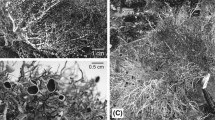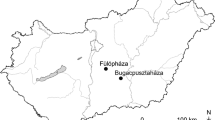Summary
Only a few small areas of the coast of north Victoria Land are free of ice. Such an area is Birthday Ridge, Yule Bay, where a lichen vegetation is developed in the interspaces of granitic rocks of the mountaintop detritus. The largest and most frequent lichen is Usnea sulphurea, growing as a “light” form at exposed habitats and as a “shade” form below pebbles. Both forms differ by chlorophyll content and temperature dependency of net photosynthesis, which demonstrates an adaptive response of these forms to their environment. Usnea sulphurea is able to take up water from humid air, but in its natural habitat it is moistened mostly by melting snow. CO2-gas exchange is detectable when the water content of the thalli rises above 30% of the dry weight. A decrease of net photosynthesis at very high water contents (at 6°C) is not visible. At a CO2 concentration of the air below 200 ppm the lichens have a negative CO2 balance; net photosynthesis is still not saturated at 370 ppm CO2 in the air under the experimental conditions. Like other antarctic lichens, U. sulphurea is a moderately productive, slowly growing species.
Similar content being viewed by others
References
Brown DH (1980) Notes on the instability of extracted chlorophyll and a reported effect of ozone on lichen algae. Lichenologist 12: 151–154
Ertl L (1951) Über die Lichtverhältnisse in Laubflechten. Planta 39:245–270
Farrar IT, Smith DC (1976) Ecological physiology, of the lichen Hypogymnia physodes. 3. The importance of the rewetting phase. New Phytol 77:115–125
Friedmann IE (1977) Microorgranisms in Antarctic desert rocks from dry valleys and Dufek Massif. Antarct J U S 13:26–29
Friedmann IE (1978) Melting snow in the dry valleys is a source of water for endolithic microorganisms. Antarct J US 13:162–163
Friedmann IE (1982) Endolithic microorganisms in the Antarctic cold desert. Science 215:1045–1053
Gannutz TP (1969) Effects of environmental extremes on lichens. Bull Soc Bot Fr Mem, Colloq. Lichens 1967:169–179
Gannutz TP (1970) Photosynthesis and respiration of plants in the Antarctic Peninsula area. Antarct J U S 5:49–51
Green ATG, Snelgar WP (1981) Carbon dioxide exchange in lichens. Plant Physiol 68:199–201
Holden M (1965) Chlorophylls. In: Goodwin TG (ed) Chemistry and biochemistry of plant pigments. Academic Press, London New York, pp 461–488
Hooker TN (1980a) Factors affecting the growth of antarctic crustose lichens. Br Antarct Surv Bull 50:1–19
Hooker TN (1980b) Growth and production of Cladonia rangiferina and Sphaerophorus globusus on SitSigny Island, South Orkney Islands. Br Antarct Surv Bull 50:27–34
Hooker TN (1980c) Growth and production of Usnea antarctica and U. fasciata on Signy Island, South Orkney Islands. Br Antarct Surv Bull 50:35–49
Kappen L, Friedman EI, Garty J (1981) Ecophysiology of lichens in the Dry Valleys of Southern Victoria Land, Antarctica. 1. Microclimate of the cryptoendolithic lichen habitat. Flora 171:216–235
Kappen L, Lange OL (1972) Die Kälteresistenz einiger Makrolichenen. Flora 161:1–29
Kappen L, Lange OL, Schulze ED, Evenari M, Buschbom U (1979) Ecophysiological investigations on lichens in the Negev desert. 6. Annual course of the photosynthetic production of Ramalina maciformis. Flora 168:85–108
Lange OL (1965) Der CO2-Gaswechsel von Flechten bei tiefen Temperaturen. Planta 64:1–19
Lange OL (1980) Moisture content and CO2 exchange of lichens. Oecologia 45:82–87
Lange OL, Kappen L (1972) Photosynthesis of lichens from Antarctica. Antarct Res Ser 20:83–96
Lange OL, Tenhunen JD (1981) Moisture content and CO2 exchange of lichens. 2. Depression of net photosynthesis in Ramalina maciformis at high water content is caused by increased thallus carbon dioxide diffusion resistance. Oecologia 51:426–429
Larcher W (1980) Ökologie der Pflanzen. Ulmer, Stuttgart
Lewis MC, Callaghan TV (1976) Tundra. In: Monteith JL (ed) Vegetation and the atmosphere. Academic Press, London New York San Francisco, pp 399–434
Lewis-Smith RJ (1978) Summer and winter concentrations of sodium, potassium and calcium in some maritime antarctic cryptogams. J Ecol 66:891–909
Lindsay DC (1973) Estimates of lichen growth rates in the maritime Antarctic. Arct Alp Res 5:341–346
Lindsay DC (1975) Growth rates of Cladonia rangiferina (L) Web. on South Georgia. Brit Antarct Surv Bull 40:49–53
Longton RE, Holdgate MW (1967) Temperature relationships of Antarctic vegetation. Philos Trans R Soc London Ser B 252:237–250
Mac Lamb MJ (1939) A review of the genus Neuropogon (Nees and Flot.) Nyl., with special reference to the Antarctic species. J Linn Soc London, Bot 52:199–237
Mac Lamb MJ (1964) Antarctic lichens. 1. The Genera Usnea, Ramalina, Himantormia, Alectoria, Cornicularia. Br Antarct Surv Sc Rep 38:1–34
Rudolph ED (1966) Lichen ecology and microclimate studies at Cape Hallett, Antarctica. Proc 4th Int Biometeorological Congr. Lichen ecology: Oxford, pp 900–910
Rundel PW (1972) CO2 Exchange in ecological races of Cladonia subtenuis. Photosynthetica 6:13–17
Schofield E, Ahmadjian V (1972) Field observations and laboratory studies of some Antarctic cold desert cryptograms. Antarct Res Ser 20:97–142
Seppelt RD, Ashton DH (1978) Studies on the ecology of the vegetation at Mawson Station. Aust J Ecol 3:373–388
Author information
Authors and Affiliations
Rights and permissions
About this article
Cite this article
Kappen, L. Ecology and physiology of the Antarctic fruticose lichen Usnea sulphurea (Koenig) Th. Fries. Polar Biol 1, 249–255 (1983). https://doi.org/10.1007/BF00443196
Received:
Accepted:
Issue Date:
DOI: https://doi.org/10.1007/BF00443196




